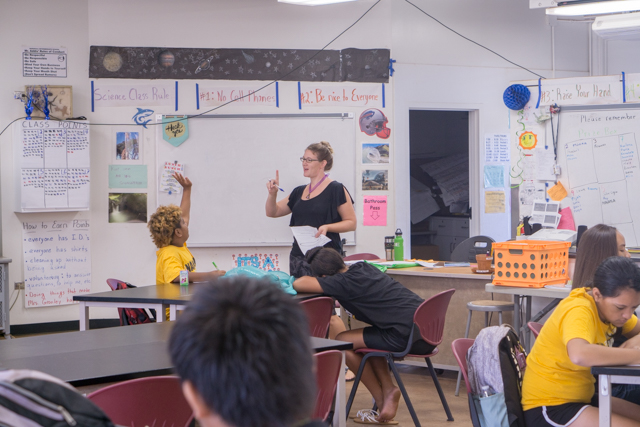Advisory, a new way to get ready for the day
Alison Gronley works with students during the new Advisory time in the morning.
This year the 7th and 8th grade students have an advisory period at 7:50 in the morning on Tuesday to Fridays instead of study hall or free time.
Last year, teachers were required to hold meetings before the first period of the day and so students who came early to campus were left with free time before the 8:20 bell.
This school year, middle school teachers are now holding advisory and the high school teachers are holding study hall in the morning.
The new addition to the school year has had benefits as well as challenges.
Advisory is a thirty minute class where middle school students go to a classroom and they get ready for the day. The advisory classes use a new learning system called “Second Steps” and it addresses all types of learning.
Ami Akeo middle school Assistant Principal said, ”What we’re doing now is our teachers are following a lesson; we’ve adopted some modifications, it’s called ‘Second Steps.’ It’s a curriculum that addresses social, emotional learning.”
Advisory was created so middle school students can build relationships as well as get important information about what is happening in school.
”One of the things we saw over and over was the need to have an advisory so kids can feel connected. They would have a place to check in to every morning and that we could roll out very important information as well as new learnings that need to happen with our middle school students,” said Akeo.
The middle school students have advisory Tuesday through Friday, this way students can check in almost everyday, however, they don’t have advisory on Mondays due to the early first period at 7:55 am.
Some teachers believe that the intermediate students should have advisory on Monday as well, while others believe they should have less advisory classes.
“Right now we have it four out of the five days. If we have it everyday that would be better,” said Ronald Yanos Advisory teacher.
Alison Gronley Advisory teacher said, ”I think I would like it to be more informal and I don’t think we need it everyday. I think two or three days a week, maybe Monday, Friday, check in with them at the beginning of the week and at the end.”
The teachers like the advisory due to the ability to better connect with a small group of students.
”The benefits of advisory is it allows the teachers to form a closer relationship with their students. We have time to meet with them, outside of a content class,” said Kristine Ginoza Advisory teacher.
Yanos said, “I get to connect with a group of students and kind of keep track of them and help them get through the school year.”
Some of the student benefits are being able to have a chance to get supplies and projects ready before school.
“It helps us to figure out what we’re gonna do for like homeroom instead of just going straight to first period,” said 7th grader Kristen Bivas’asagra.
For high school students, this morning period is used as study hall or students remain in the cafe after eating breakfast.
“To keep it so we don’t have kids wandering and especially because there’s not a lot of supervision once the bell rings,” said Akeo.
The high school students feel that the benefits are having that time to get work done.
Harley-Rose Kon 9th grader said,”If you are a dual credit or advanced class then I get that it’s kind if a good thing.”
The high school teachers believe that some benefits of having advisory are to help students so everyone is successful.
“Advisory provides additional opportunities to get help that is necessary to be successful. Advisory allows them to have possible one on one time or smaller groups to get the assistance that they need,” said Joseph Matian 9th grade Math teacher.
However, the advisory has some challenges when it comes to the morning time and being able to connect with students.
Gronley said, ”Definitely the morning aspect of it because having to be in your class with kids by 7:50 doesn’t give me any time to get ready for the day.”
Yanos said, ”Some of the challenges are being able to make connections with students. Some students are very quiet and to themselves and they don’t really want to talk about what’s happening outside of school.”
The students have challenges as well; some students feel that advisory should be shorter.
”If I could change it I would make it a little shorter because then we could just move on for the day,” said 7th grader Kailyn Oili.
Other challenges are some teachers let the kids do whatever they want in class.
Kon said, ”Depending on the teacher that you go to, most teachers just let you do whatever. Certain teachers tell you you have to pull out some type of work.”
Students also feel that advisory has its distractions. Bivas’asagra said,“It’s kind of hard because people are so loud and everything because it’s the first thing in the morning.”
Some teachers feel that students are not taking this opportunity to get help.
Thomas Ehrman 9th grade English teacher said, ”Turns out it isn’t as good as I would like. A lot of students who need help just aren’t coming.”
One thing the teachers would change about advisory is to have students be in a classroom, doing work.
Ehrman said, ”I suppose if there was anything I would change it would be to make it mandatory. That you would have to be in someone’s room doing something.”
Advisory was put in so students can be more connected and build bonds with their teachers.
”It wasn’t just my decision but we really are focusing on relationships and addressing the middle level education for our middle school students,” Akeo said.


